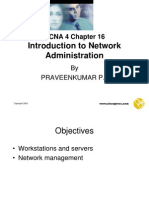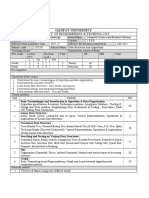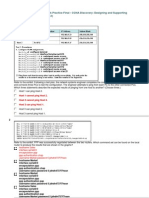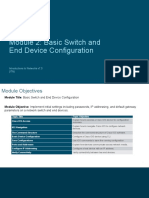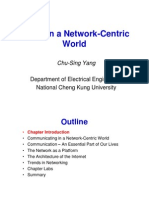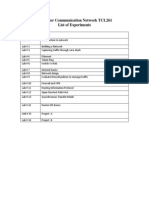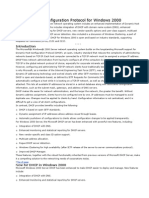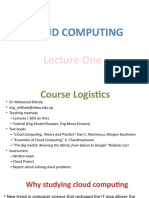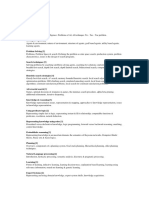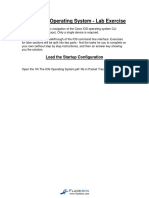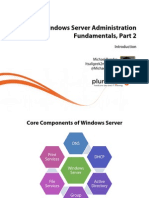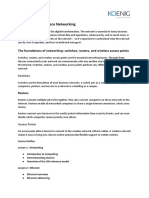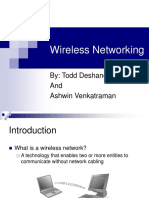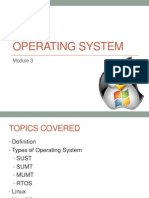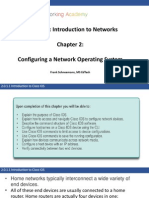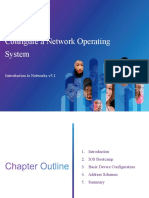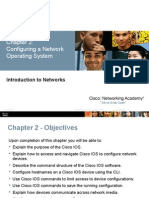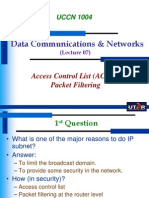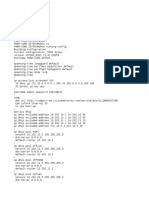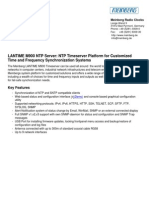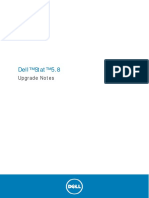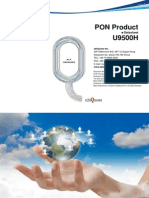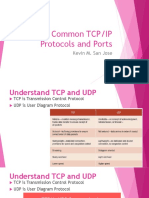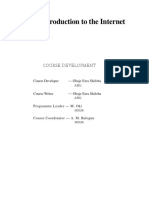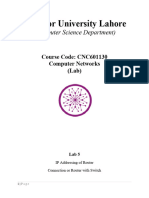Basic Switching and Switch
Configuration
Dinesh R. Lankireddy
�Switch Overview
Switches contain CPU, RAM,
Operating System
POST
When switched on System LED
indicates status
Color System Status
Off
System is not powered on.
Green System is operating normally.
Amber System is receiving power but
is not functioning properly.
�Status LED Overview
Mode button toggles
between different port
modes
Port mode displayed on Port
Mode LEDs
Individual Port status above
each port
�Port Status 1
�Port Status 2
�Configuring a Network
Operating System
Dinesh R. Lankireddy
�Objectives
Upon completion of this chapter you will be able to:
Explain the purpose of the Cisco IOS.
Explain how to access and navigate Cisco IOS to configure network devices.
Describe the command structure of the Cisco IOS software.
Configure hostnames on a Cisco IOS device using the CLI.
Use Cisco IOS commands to limit access to device configurations.
Use Cisco IOS commands to save the running configuration.
Explain how devices communicate across network media.
Configure a host device with an IP address.
Verify connectivity between two end devices.
�Cisco IOS
Operating Systems
All networking equipment dependent on operating systems
The operating system on home routers is usually called firmware
Cisco IOS Collection of network operating systems used on Cisco devices
�Cisco IOS
Purpose of OS
PC operating systems (Windows 8 and OS X) perform technical functions
that enable:
Use of a mouse
View output
Enter text
Switch or router IOS provides options to:
Configure interfaces
Enable routing and switching functions
All networking devices come with a default IOS
Possible to upgrade the IOS version or feature set
In this course, primary focus is Cisco IOS Release 15.x
�Cisco IOS
Location of the Cisco IOS
Cisco IOS stored in Flash
Non-volatile storage, not lost when power is lost
Can be changed or overwritten as needed
Can be used to store multiple versions of IOS
IOS copied from flash to volatile RAM
Quantity of flash and RAM memory determines IOS that can be used
�Cisco IOS
IOS Functions
These are the major functions performed or enabled by Cisco routers and
switches.
�Cisco Software components
Cisco IOS (Internetwork Operating System)
It is the operating system that manages the hardware
platform it is working on.
Configuration File
It is a program file that contains commands that
reflect how the router will react.
�Router Internal Components
�An Overview of Cisco Device Startup
�Step in Router Initialization
�Computer/Terminal Console Connection
�Accessing a Cisco IOS Device
Console Access Method
Most common methods to access the CLI:
Console
Telnet or SSH
AUX port
�Accessing a Cisco IOS Device
Console Access Method
Console Port
Device is accessible even if no networking services have been configured
(out-of-band)
Need a special console cable
Allows configuration commands to be entered
Should be configured with passwords to prevent unauthorized access
Device should be located in a secure room so console port cannot be easily
accessed
�Accessing a Cisco IOS Device
Terminal Emulation Programs
Software available for
connecting to a networking
device:
PuTTY
Tera Term
SecureCRT
HyperTerminal
OS X Terminal
�Putty Session Properties
�Accessing a Cisco IOS Device
Telnet, SSH, and AUX Access Methods
Telnet
Method for remotely accessing the CLI over a network
Require active networking services and one active interface that is
configured
Secure Shell (SSH)
Remote login similar to Telnet, but utilizes more security
Stronger password authentication
Uses encryption when transporting data
Aux Port
Out-of-band connection
Uses telephone line
Can be used like console port
�Navigating the IOS
Cisco IOS Modes of Operation
�Navigating the IOS
Primary Modes
�Navigating the IOS
Global Configuration Mode and
Submodes
�Navigating the IOS
Navigating Between IOS Modes
�Navigating the IOS
Navigating Between IOS Modes (cont.)
�The Command Structure
IOS Command Structure
�The Command Structure
Cisco IOS Command Reference
To navigate to Ciscos IOS Command Reference to find a command:
1.
Go to http://www.cisco.com.
2.
Click Support.
3.
Click Networking Software (IOS & NX-OS).
4.
Click 15.2M&T (for example).
5.
Click Reference Guides.
6.
Click Command References.
7.
Click the particular technology that encompasses the command you
reference.
8.
Click the link on the left that alphabetically matches the command you
referencing.
9.
Click the link for the command.
�The Command Structure
Context-Sensitive Help
�The Command Structure
Command Syntax Check
�The Command Structure
Hot Keys and Shortcuts
Tab Completes the remainder of a partially typed command or
keyword.
Ctrl-R Redisplays a line.
Ctrl-A Moves to the beginning of the line.
Ctrl-Z Exits the configuration mode and returns to user EXEC.
Down Arrow Allows the user to scroll forward through former
commands.
Up Arrow Allows the user to scroll backward through former
commands.
Ctrl-shift-6 Allows the user to interrupt an IOS process such as ping
or traceroute.
Ctrl-C Exits the current configuration or aborts the current command.
�The Command Structure
IOS Examination Commands
�The Command Structure
Default configuration
When powered up w/out configuration, the
default name is Switch.
No passwords have been configured.
All switch ports are part of VLAN 1
Switch has no IP address
Show version shows the IOS version and the
configuration register.
�The Command Structure
The show version Command
�User Mode Commands
�show interfaces Command
�Interpreting the Interface Status
S0/1
S0/0
Interface is
working
properly
Layer 1 status
Layer 2 status
Other interface status :
- Serial0/1 is administratively down , line protocol is down
interface is shut down
- Serial0/1 is down , line protocol is down
interface or cable H/W failure ( no keep-alives )
- Serial0/1 is up , line protocol is down
different encapsulation type ( PPP , HDLC , FR ) or no clock rate
DCE device.
on the
�Serial Interface show controller
Command
Shows the cable type of serial cables
�Discovering Neighbors with CDP
CDP runs on routers with Cisco IOS
to get information about the direct
connected Cisco devices.
Summary information
includes:
Device identifiers
Address list
Port identifier
Capabilities list
Platform
�Using the show cdp
neighbors Command
RouterA# show cdp neighbors detail
provide also the neighbors ip addresses.
�Using Telnet to Connect to Remote
Devices
Telnet is used to check all the
TCP/IP stack
�Using the ping and trace
Commands
Ping commands tests the connectivity and path to a remote device
( test layer 3 in TCP/IP )
�Before Configuring a switch
Erase any existing settings
VLAN database
Configuration in NVRAM
Reload the switch
�Lets Start
Creating a two PC network connected via a switch
Setting a name for the switch
Limiting access to the device configuration
Configuring banner messages
Saving the configuration
�Hostnames
Device Names
Some guidelines for naming conventions:
Start with a letter
Contains no spaces
Ends with a letter or digit
Uses only letters, digits, and dashes
Be less than 64 characters in length
Without names, network
devices are difficult to
identify for configuration
purposes.
�Hostnames
Configuring Device Names
Hostnames allow
devices to be
identified by network
administrators over
a network or the
Internet.
�Hostnames
Configuring Hostnames
�Limiting Access to Device Configurations
Securing Device Access
These are device access passwords:
enable password Limits access to the privileged EXEC mode
enable secret Encrypted, limits access to the privileged EXEC
mode
console password Limits device access using the console
connection
VTY password Limits device access over Telnet
Note: In most of the labs in this course, we will be using simple
passwords such as cisco or class.
�Limiting Access to Device Configurations
Securing Privileged EXEC Access Mode
Use the enable secret command, not the older enable
password command.
The enable secret command provides greater security because the
password is encrypted.
�Limiting Access to Device Configurations
Securing User EXEC Access
Console port must be secured; it reduces the chance of unauthorized
personnel physically plugging a cable into the device and gaining
device access.
VTY lines allow access to a Cisco device via Telnet. The number of VTY
lines supported varies with the type of device and the IOS version.
�Limiting Access to Device Configurations
Encrypting Password Display
service passwordencryption
Prevents passwords
from showing up as
plain text when
viewing the
configuration
Keeps unauthorized
individuals from
viewing passwords
in the configuration
file
Once applied,
removing the
encryption service
does not reverse the
encryption
�Limiting Access to Device Configurations
Banner Messages
Important part of
the legal process in
the event that
someone is
prosecuted for
breaking into a
device
Wording that implies
that a login is
"welcome" or
"invited" is not
appropriate
Often used for legal
notification because
it is displayed to all
connected terminals
�Configuring Router Identification
�Configuring a Router Password
�Saving Configurations
Configuration Files
Switch# reload
System configuration
has been modified. Save?
[yes/no]: n
Proceed with reload?
[confirm]
Startup configuration is
removed by using the erase
startup-config
Switch# erase startupconfig
On a switch, you must also
issue the delete
vlan.dat
Switch# delete
vlan.dat
Delete filename
[vlan.dat]?
Delete flash:vlan.dat?
[confirm]
�Ports and Addresses
IP Addressing of Devices
Each end device on a
network must be
configured with an IP
address.
Structure of an IPv4
address is called dotted
decimal.
IP address displayed in
decimal notation, with
four decimal numbers
between 0 and 255.
With the IP address, a
subnet mask is also
necessary.
IP addresses can be
assigned to both physical
ports and virtual
interfaces.
�Ports and Addresses
Interfaces and Ports
Network communications depend on end user device interfaces,
networking device interfaces, and the cables that connect them.
Types of network media include twisted-pair copper cables, fiber-optic
cables, coaxial cables, or wireless.
Different types of network media have different features and benefits.
Ethernet is the most common local area network (LAN) technology.
Ethernet ports are found on end user devices, switch devices, and other
networking devices.
Cisco IOS switches have physical ports for devices to connect to, but also
have one or more switch virtual interfaces (SVIs; no physical hardware on
the device associated with it; created in software).
SVI provides a means to remotely manage a switch over a network.
�Addressing Devices
Configuring a Switch Virtual Interface
IP address Together with subnet mask, uniquely identifies end device on
internetwork.
Subnet mask Determines which part of a larger network is used by an IP
address.
interface VLAN 1 Available in interface configuration mode,
ip address 192.168.10.2 255.255.255.0 Configures the IP
address and subnet mask for the switch.
no shutdown Administratively enables the interface.
Switch still needs to have physical ports configured and VTY lines to enable
remote management.
�Addressing Devices
Configuring a Switch Virtual Interface
�Addressing Devices
Manual IP Address Configuration for End Devices
�Addressing Devices
Automatic IP Address Configuration for End Devices
�Addressing Devices
IP Address Conflicts
�Verifying Connectivity
Test the Loopback Address on an End Device
�Verifying Connectivity
Testing the Interface Assignment
�Verifying Connectivity
Testing End-to-End Connectivity
�Configuring a Network Operating System
Summary
Cisco IOS:
The technician can enter commands to configure, or program, the device
to perform various networking functions.
Services are generally accessed using a command-line interface (CLI),
which is accessed by either the console port, the AUX port, or through
telnet or SSH.
Once connected to the CLI, network technicians can make configuration
changes to Cisco IOS devices.
Cisco IOS is designed as a modal operating system, which means a
network technician must navigate through various hierarchical modes of
the IOS.
Cisco IOS routers and switches support a similar modal operating system,
support similar command structures, and support many of the same
commands. In addition, both devices have identical initial configuration
steps when implementing them in a network.





